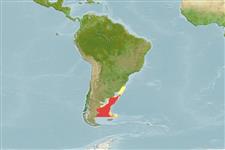Common names from other countries
Environment: milieu / climate zone / depth range / distribution range
экология
пелагический; пределы глубины 0 - 800 m (Ref. 275), usually 50 - 200 m (Ref. 275). Subtropical, preferred 10°C (Ref. 107945); 20°S - 50°S, 68°W - 46°W (Ref. 275)
Southwest Atlantic, Southeast Pacific and Antarctic Indian Ocean. Subtropical to polar.
Length at first maturity / Size / Вес / Возраст
Maturity: Lm ?, range 24 - ? cm Max length : 40.0 cm ML самец/пол неопределен; (Ref. 105659)
Life cycle and mating behavior
половая зрелость | размножение | нерест | икра | Fecundity | личинки
Members of the class Cephalopoda are gonochoric. Male and female adults usually die shortly after spawning and brooding, respectively. Mating behavior: Males perform various displays to attract potential females for copulation. During copulation, male grasp the female and inserts the hectocotylus into the female's mantle cavity where fertilization usually occurs. Life cycle: Embryos hatch into planktonic stage and live for some time before they grow larger and take up a benthic existence as adults.
Основная ссылка
ссылки | координатор | соавторы
Roper, C.F.E., M.J. Sweeney and C.E. Nauen. 1984. (Ref. 275)
Статус Красного Списка МСОП (Ref. 130435)
Статус СИТЕС (Ref. 108899)
Not Evaluated
Not Evaluated
Использование человеком
рыболовство: коммерческий
FAO - рыболовство: landings, Видовой профиль | FishSource | Sea Around Us
инструменты
дополнительная информация
Возраст/РазмерыростЗависимость между длиной и массой телаЗависимость между длинамиморфологияличинкичисленность
ресурсы в Интернет
Estimates based on models
Preferred temperature
(Ref.
115969): 4.4 - 12.1, mean 7.3 (based on 234 cells).
устойчивость к внешним воздействиям
высокий, минимальное время удвоения популяции до 15 месяцев (K=0.93-0.96).
Prior r = 1.00, 95% CL = 0.66 - 1.49, Based on 1 data-limited stock assessment.
Уязвимость
Low vulnerability (19 of 100).
